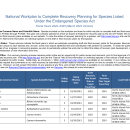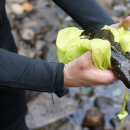Working with partners, the U.S. Fish and Wildlife Service (Service) uses a range of conservation tools to recover threatened and endangered species to ensure that they are able to survive on their own in the wild. These tools can include acquiring and restoring habitat, removing invasive species invasive species
An invasive species is any plant or animal that has spread or been introduced into a new area where they are, or could, cause harm to the environment, economy, or human, animal, or plant health. Their unwelcome presence can destroy ecosystems and cost millions of dollars.
Learn more about invasive species , conducting surveys, monitoring individual populations, and breeding species in captivity to release them into their historic range.
One of these tools is the species’ recovery plan. Recovery plans provide a road map with detailed site-specific management actions for private, Tribal, federal, and state cooperation in conserving listed species and their ecosystems. A recovery plan provides guidance on how best to help listed species achieve recovery, but it is not a regulatory document.
A Revised Approach
Recovery plans often take a long time to develop and are not easy amended to reflect new information, changing needs, or environmental conditions. By improving and streamlining the way we develop recovery plans, we will develop and implement strategic recovery plans more rapidly and provide the flexibility needed to adapt to new information or circumstances affecting species.
Therefore, the Service has revised its approach to recovery planning and implementation. Now, the recovery plan is just one piece of a three-part framework; it is informed by the Species Status Assessment, and is implemented via the Recovery Implementation Strategy.
The Species Status Assessment
The foundation supporting recovery plans is a Species Status Assessment (SSA). An SSA includes much of the information and analyses previously housed in the “background” section of a recovery plan, but it also assesses this information in a more explicit and deliberative manner. Similar to the “background” in traditional recovery plans, the SSA includes analysis of the species’ historic and current conditions, and also includes further analyses such as future projections of population trends under varying threat conditions, and potential management regimes. The SSA is structured around the conservation biology principles of the 3Rs – Resiliency, Representation and Redundancy.
Learn more about species status assessments.
The Recovery Plan
Under the revised approach, recovery plans are streamlined: they contain a concise introduction that includes the vision of what the species’ recovered state looks like, described in terms of the 3Rs, and the threats that need to be ameliorated, as well as a recovery strategy of how we intend to get there. The main body of the recovery plan comprises the statutorily required Endangered Species Act (ESA) elements of recovery criteria, recovery actions, and estimates of the time and costs to achieve the plans goals. Recovery Criteria and Actions Identification of the species’ needs in the SSA and the assessment of the current and future conditions should lead logically to the expression of these needs/conditions in the form of recovery criteria, which will measure progress toward and achievement of the desired recovered state. Recovery criteria are expressed in terms of the 3Rs describing the biological state of recovery, and the ameliorated or mitigated state of the threats that facilitate achievement of the biological criteria, as well as the long-term persistence of these conditions.
Another significant component of the recovery plan is the delineation of recovery actions. Recovery actions are those actions necessary to bring each threat from its current state to the state described by the recovery criterion for that threat. In this new approach, actions are focused at an over-arching, more “visionary” level while still maintaining the site specific connection required under the ESA; estimates of the time and cost to achieve the actions (and thus the criteria) are still required and are not changed under RPI. The on-the-ground activities to implement the actions are detailed in the separate Recovery Implementation Strategy (RIS). Recovery actions in the recovery plan are prioritized to address the most significant threats first, in order to achieve the most recovery in the least amount of time.
The Recovery Implementation Strategy (RIS)
Historically, a recovery plan has been a more static document. Under the ESA, it has statutory elements that require public review and comment, which can take a considerable amount of time and resources. As a result, many recovery plans have become outdated. However a species’ biological condition, threats to its existence, and our understanding of how to address these stressors can change frequently and significantly. The Recovery Implementation Strategy (RIS), is a short-term, more flexible operational document focused on how, when, and with whom the recovery actions will be implemented. Including the activities and how they are implemented in this separate “stepped-down” document allows us to be able to adapt to changing circumstances and thus have a more flexible recovery strategy.
The RIS will be developed with our conservation partners, and focus on the period of time and scope of activities that work best for our partners to achieve recovery goals. Many RISs can be developed, specific to partners and/or activities, and can cover varying timeframes, as needed. If multiple RISs are developed, an ‘umbrella framework’ or overarching RIS, outlining the relationships and priorities among the individual RISs, is developed to ensure strategic implementation of the overall recovery program for the species.
Taking advantage of the flexibility of the RIS does not absolve the Service from revising recovery plans, should new information indicate a need to revise statutory elements such as the recovery criteria or the over-arching actions in the plan, but should significantly reduce the number of revisions necessary over the course of the species recovery, saving the time and costs involved in revisions and allowing the recovery program for the species to remain relevant and effective for longer periods of time.













